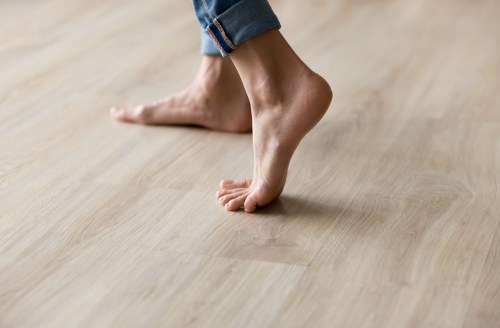Social distancing in light of the COVID-19 pandemic has been challenging in a number of ways, but one silver lining it’s presented is that it’s led me to discover a new mindfulness practice that I find helpful and oh-so easy to stick with. Now, when I’m feeling introspective and not quite in the mood for interpersonal connection with friends to talk about it (despite the new outpouring of invitations for virtual hangouts), indoor meditative walking using one of my go-to apps is also an option.
Pacing (à la my new phone ritual) is kind of an under-the-radar wellness practice, and when you slow it way down, meditation teacher Dan Vazquez (who’s currently teaching on MNDFL TV), says you end up with a de-stressing practice to guide you through the good and bad—indoors and outdoors. “Mindful walking is a great way to destress and bring mindfulness into daily life,” says Vazquez. “Traditionally, people walk back and forth, about 20 paces or so. The back and forth is to emphasize that there is nowhere to go, nowhere to be.” It’s basically slow-motion walking—and it slows down your mind right along with your body.
Eve Lewis, Headspace content director, adds that while seated meditation focuses on the mind, its walking counterpart does a diagnostic of how your body as a whole is feeling. “Walking meditation allows us to focus on the movement of our body, which in turn gets us out of our heads and into the present moment of walking and moving,” she says. “In sitting meditation, we focus our attention on the breath as a point of focus to come back to, whereas in walking meditation, the focus is on the movement of our body, specifically the feet moving up and down.”
“Walking meditation allows us to focus on the movement of our body, which in turn gets us out of our heads and into the present moment of walking and moving.” —Eve Lewis, Headspace content director
And, yes: You can absolutely do indoor meditative walking just as you can when you’re out and about, social distancing in nature. But beyond these trying times, meditative walking is a skill worth carrying with you far into the future as well (you know, when we’re all back to our normally scheduled programming). “Look for moments in the day where you place your attention on the movement of the body,” says Lewis. “This could be as simple as going from sitting to standing and from standing to sitting or even put reminders in to check your posture if you are in front of a screen for most of the day.”
Headspace recently introduced an indoor walking meditation as part of its free “weathering the storm” content, designed to help you keep your cool amid the pandemic (so you can try an audio-guided at-home walk by downloading the app). Or, scroll down to get step-by-step instructions from Vazquez and Lewis for DIY-ing your indoor meditative walking practice.
How to practice indoor meditative walking in 6 easy steps, according to meditation pros.
1. Ground yourself
Take a moment before you begin to walk to feel the sensation of your feet on the ground. Keeping your eyes open with a soft focus just in front you, take a big, deep breath in through the nose and out through the mouth. And as you breathe out through the mouth, begin to walk.
2. Walk at a pace that feels natural and comfortable
To begin with, walk at a normal speed. If you are feeling stressed, this might be quite quick to start with: walking, pausing, turning around and walking back again. Just get comfortable, bringing the mind into the body and noticing how the body feels as you walk.
3. Notice your walking rhythm
Start to notice the movement of the body, the arms, the legs, the hands, the feet. But, in particular, notice the movement of the legs and the rhythm of the legs moving backward and forward.
4. Mindfully slow your pace
Gradually start to slow it down a little bit, so each and every time you set out to walk, just slow it down by about 10 percent each time. As you continue to walk, start to notice the sensation of the foot pressing against the floor. Feel one foot pressing down, then the pressure easing off as you lift the foot. Then feel the next foot pushing down, the sensation of it lifting off.
5. Settle into the new rhythm of your indoor meditative walking session
Still be aware of the space around you, and still be aware of the rest of the body, but start to slow down. Walk slower as you rest the attention on the sensation of one foot and then the next. And then the next. And then the next, just staying with that rhythm.
6. Mindfully end your practice
Any time you get distracted, just notice it, let it go, and bring the attention back to the feet. Continue for as long as you want, and when you finish, return to a standing position and take a big deep breath.
If you’re having trouble drawing attention into your body, Vazquez recommends observing your environment instead. “If you feel inspired to play, get creative with it. Maybe for part of the time, tune into the sounds of the environment as you’re walking; then tune into the colors, shapes, light, and shadows. Then tune into what’s happening in the mind, observing the thoughts and floating in awareness.” You can also match your footsteps to words: right foot, here; left foot, now.
Really, what you’re accomplishing with indoor meditative walking is the quality of communication with yourself that you aim to have with friends near and far, during times of social distancing and beyond. So, consider it life skill worth developing for any time, but one you can mindfully maximize in the present.
Here’s what to know about differences between two popular meditation apps: Headspace and Calm. And, if you’re feeling isolated from those you love, compassion meditation is the ticket to feeling more connected.
Sign Up for Our Daily Newsletter
Get all the latest in wellness, trends, food, fitness, beauty, and more delivered right to your inbox.
Got it, you've been added to our email list.











